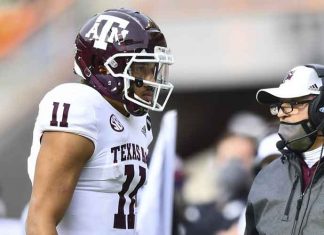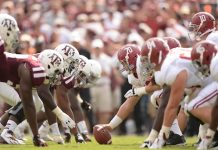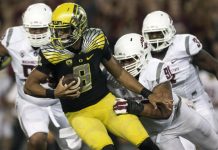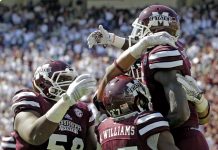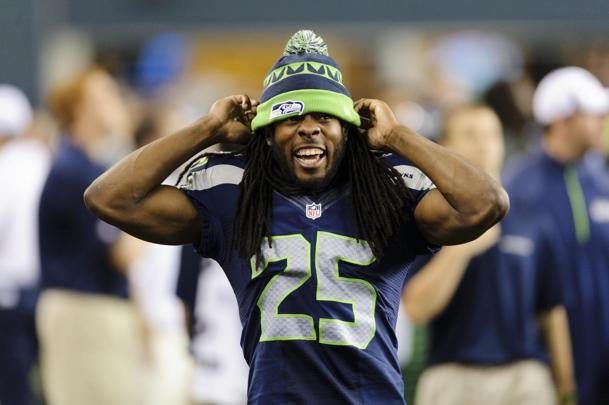Success for a college football coach is best determined over an extended period of time.
Impatient Florida State fans might not want to hear that these days. Willie Taggart will enter Season 2 as Seminoles coach trying to rebound from maybe the worst debut of any of last season’s first-year FBS coaches. Florida State (5-7) missed a bowl game for the first time since 1981.
Same goes for Chip Kelly at UCLA (3-9). Kelly’s first season was even worse than Taggart’s. The nature of the fanbases and program expectations mean Kelly is likely to be extended more patience in rebuilding than Taggart. The last recruiting cycle, however, suggests the forecast for UCLA’s resurgence under Kelly might have been overly optimistic.
Last year’s Most Likely to Succeed ranking for newly hired head coaches in FBS had Kelly No. 1 and Taggart No. 2. So, yeah, now is a good time to remind you the Most Likely to Succeed list is a long-term projection based how the coach fits, program expectations and resources, and the coach’s ability to meet expectations and maximize resources.
Two years ago, Jeff Brohm of Purdue and P.J. Fleck of Minnesota were Nos. 1 and 2 on the first Most Likely to Succeed list, a ranking maybe most notable for the fact that No. 6 among the 21 coaches has already been fired. Mike Sanford went 9-16, including 3-9 last year, as Brohm’s replacement at Western Kentucky. Meanwhile, Jeff Tedford, who was No. 20, is 22-6 at Fresno State.
Welp.
Undeterred, the 2019 Most Likely to Succeed list, ranking the new hires in FBS on the likelihood the coach’s tenure will ultimately be viewed as a success:
1. Dana Holgorsen, Houston
Holgorsen ducked out on a West Virginia rebuild and returned to the state of Texas, where he had success early in his career as an assistant. Looks like a shrewd move. Based on funding, facilities, recruiting territory and conference competition, it should be easier to win big with the Cougars than with the Mountaineers. That’s no knock on Holgo. He proved to be a quality coach at WVU going 61-41 overall and 38-32 in the Big 12. Hard to imagine this not working out well for everyone involved.
2. Hugh Freeze, Liberty
Liberty is a newcomer to FBS, but the school has poured millions into its football program and now has landed a coach with a tarnished reputation but a 19-21 Southeastern Conference record at Ole Miss. Success under Freeze seems likely. It could also be fleeting. Don’t expect him to hang around long if he wins.
3. Geoff Collins, Georgia Tech
Year 1 for the Yellow Jackets as Collins converts the roster from triple-option football is likely to be ugly. But look at the big picture: Georgia Tech’s backyard has never been more fertile in terms of recruiting. Players are plentiful and coming from increasingly well-resourced high schools. Collins, a native of the area and twice on staff at Tech, has the potential to be a dynamic recruiter. Considering the state of ACC Coastal competition, Georgia Tech could be primed to shift the balance of power.
4. Neal Brown, West Virginia
This is another long play. Anything better than bowl-eligibility in 2019 will be a raging success for the rebuilding Mountaineers. Brown was potentially the biggest score of the last carousel, a young coach who seems to understand the broad vision it takes to run a successful program. The ceiling for West Virginia, the eastern outlier in the Big 12, might not be much higher than what Holgorsen hit. This ranking is a bet Brown can break through it eventually.
5. Scott Satterfield, Louisville
Jilted by hometown hero, Jeff Brohm, Louisville’s plan B has big-time potential. Satterfield brings the App State way to the ACC, which was good for 51-24 in six seasons. The initial rebuild for Satterfield is even more daunting than what Collins and Brown face. Bobby Petrino left a smoldering pile of rubble behind, but fundamentals of the program are solid and so is Satterfield.
6. Manny Diaz, Miami
The more time passes since Miami’s glory days, the more it seems as if the Hurricanes will never be able to recreate them. But that shouldn’t be the benchmark for success under the 45-year-old Diaz, a first-time head coach and Miami native. The Hurricanes have won the ACC Coastal once in 15 years. That’s absurd. If Diaz can simply make that a regular occurrence, he will be a success.
7. Will Healy, Charlotte
At 34 years old, Healy is a high-upside coach who already has an impressive turnaround on his record at FCS Murray State. Charlotte is a young FBS program, playing in a Conference USA that is flush with opportunity for upward mobility. Nice combination.
8. Chris Klieman, Kansas State
Fit, fit, fit. Some K-State fans were unhappy the Wildcats ”settled” for an FCS coach, but Klieman’s recent North Dakota State teams were probably better than what Hall of Famer Bill Snyder was rolling out in his last few seasons. The North Dakota State model should fit nicely in Manhattan.
9. Mack Brown, North Carolina
Brown coached the Tar Heels from 1988-97 and led them to four seasons of at least nine victories, including three in double digits. North Carolina has surpassed nine wins in a season once since Brown left for Texas. What North Carolina needs most is stability. It doesn’t seem like too much to ask of Brown.
10. Ryan Day, Ohio State
The last five Ohio State football coaches include four Hall of Famers and Urban Meyer, who was the most successful of them all. Good luck keeping the folks in Columbus satisfied, Ryan.
11. Eliah Drinkwitz, Appalachian State
Appalachian State is a rock of a program, solid to the core. But the school went outside the family for the 36-year-old former offensive coordinator. Drinkwitz has a reputation for being brainy. Smart enough not to screw up a good thing?
12. Chip Lindsey, Troy
Another good looking fit. The Alabama native and former Auburn offensive coordinator takes over a program coming off three straight double-digit win seasons under Neal Brown. A word of caution though for Lindsey (and Drinkwitz): Fortunes can turn quickly at this level of FBS. See: Western Kentucky under Mike Sanford.
13. Mike Houston, East Carolina
Houston was 80-25 in eight seasons in Division II and FCS, including a national title at James Madison. East Carolina is a program with a proud history that has lost its way. As with most AAC programs, the faster Houston turns things around the sooner he becomes a Power Five job candidate.
14. Matt Wells, Texas Tech
The Red Raiders brought in Wells to coach the whole team, not just the offense, after six seasons of Kliff Kingsbury struggling to do just that. If success is defined as better than Kingsbury, that seems like an attainable goal for Wells. If Red Raiders fans expect to replicate Mike Leach’s success in Lubbock, they’re probably setting themselves up to be disappointed.
15. Rod Carey, Temple
After Manny Diaz bailed on Temple in January, the administration decided it needed an experienced coach whose style matched the Owls. Enter Carey, whose rugged Northern Illinois teams finished at least tied for first in the MAC West in four of six seasons. Seems like a safe hire. Maybe too safe?
16. Jake Spavital, Texas State
If nothing else, the 34-year-old Next Gen Air Raid guru should make Texas State fun and interesting.
17. Tom Arth, Akron
The 37-year-old Ohio native’s roots go back to Division III power John Carroll. It’s a hire that harkens to Buffalo bringing in Lance Leipold. That worked out great, but Arth has far less experience than Leipold did.
18. Jamey Chadwell, Coastal Carolina
Joe Moglia’s hand-picked successor takes on a program that is still trying to find its footing in FBS. His previous head coaching experience (60-35 in DII and FCS) suggests upside.
19. Mel Tucker, Colorado
Colorado has had one winning football season since 2005. Tucker, the former Georgia defensive coordinator and Alabama assistant, will try to bring Nick Saban’s Process to the Pac-12. Is Colorado ready to make the commitment necessary to execute the plan?
20. Les Miles, Kansas
The bar could not be much lower in Lawrence. Miles, the 65-year-old former LSU coach, just needs to make the Jayhawks competent. Yet, still, skepticism abounds.
21. Mike Locksley, Maryland
Locksley has deep ties to the area, which should help in both recruiting and unifying a program and community left fractured by the death of offensive lineman Jordan McNair during DJ Durkin’s tenure as head coach. Locksley also has on his resume an embarrassingly bad three-year stint as New Mexico coach. Boom or bust hire.
22. Thomas Hammock, Northern Illinois
The former NIU running back is a first-time head coach with NFL experience. He steps into a program that has been a model of consistency – no easy feat in the MAC – for about a decade. Tough spot to learn on the job.
23. Tyson Helton, Western Kentucky
Helton was Brohm’s quarterback coach and offensive coordinator when the Hilltoppers were killing it 2014 and ’15. Not a bad idea going back to that tree.
24. Walt Bell, UMass
The 34-year-old Bell takes over maybe the toughest FBS job in the country. Just getting UMass to a bowl game could merit a statue.
25. Scot Loeffler, Bowling Green
Loeffler brings Midwest roots and eight seasons as an offensive coordinator to BG. Of course, none of those offenses were particularly impressive.
26. Gary Andersen, Utah State
Certain factions at Utah State pushed for Andersen’s return after Matt Wells left. He knows the challenges of the program and has had success in Logan, but he did little to distinguish himself after leaving.
27. Jim McElwain, Central Michigan
It’s not easy for MAC schools to land experienced head coaches on the cheap, but Florida paid $7.5 million when it let go of McElwain after 2017 so here we are. Question: If McElwain was consistently unsatisfied with support and resources at Florida how does this end well?
—
Follow Ralph D. Russo at https://twitter.com/ralphDrussoAP and listen at https://podcastone.com/AP-Top-25-College-Football-Podcast
—
More AP college football: https://apnews.com/Collegefootball and https://twitter.com/AP-Top25
25% Bonus via Western Union



